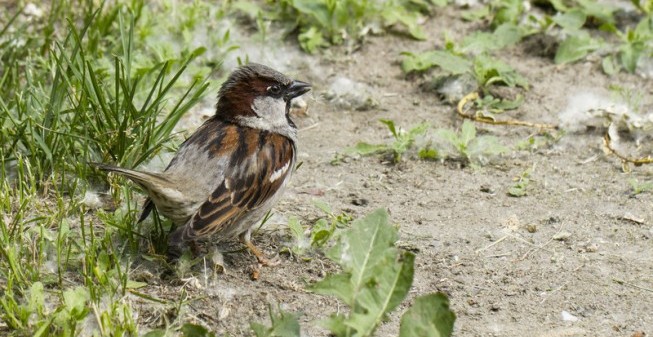How To Keep Birds Out Of Your Garden

Sometimes birds can be a welcome part of a garden on a peaceful, sunny day, but sometimes this isn’t the case. For vegetable gardeners, little birdies can eat your precious new growth and some birds can leave quite a mess, especially if you have a lot of avian visitors. There are several humane ways to keep birds out of your garden regardless of whether you find yourself constantly cleaning up after bird droppings, or are just concerned about the damage that they can cause.
Some species are particularly problematic. For example, both blackbirds and starlings will tend to eat your fruits and vegetables. In fact, if birds start getting too fond of your garden you might start to find entire crops destroyed!
There are a number of tricks that can majorly help to reduce the bird presence in your garden, but even then, sometimes you might run into the odd stubborn bird that is going to come back no matter what. Birds can be really smart despite having a bird brain (lol), so let’s work together to think of something!
My Personal Experience
First though, I just wanted to share two quick stories on my personal experience with how destructive these animals can be. My grandparents live on a few acres of property and love gardening. They have grape vines, peaches, nectarines, fuyu persimmons, apples, oranges, guavas, lemons….OK, you get the picture, it’s a lot of stuff.
Last year, the birds were terrible. They almost completely wiped out the persimmon tree by pecking holes in nearly all of the fruit. We were able to salvage some of it, but a flock of birds can do serious damage to one seasons fruit crop in just a few days.
The worst of the damage was to the okra though! My grandmother planted a whole row of okra, and over the course of a week, cute little finches discovered a taste for okra seedlings and ate everything down to the nub. No okra survived!
OK, let’s move on to the tactics.
Scare Them Visually Or With Sound
Both sound-based and visual approaches can be very effective ways of scaring birds. One simple example of this is to hang up things that are going to make noise in the wind, such as bunches of cutlery or specific products designed for that purpose. You could also use things that are going to sound nice blowing in the wind, so you don’t have to listen to tin cans banging around all the time.
The downside with this is that you won’t have much way to scare birds off when it isn’t windy.
On the other hand, there are many devices out there that will periodically make noise as well as ones that will make noise when they detect movement. If you are trying this out it’s important to pick a device that changes the sound it produces. For example, it might change the specific sound, the sequence, the frequency, the duration or any combination of these features.
Birds quickly learn what is and what is not actually dangerous. So, before long they will simply ignore the noise. It’s why you see birds in the park hopping around without a care, because they learned people and cars largely ignore them. If the noise is changing the birds are much more likely to keep viewing it as a threat, or at least be suspicious.
The same is true for visual deterrents. Anything that just stays still and stays the same won’t be an effective deterrent for very long. One way around this is to have deterrents that move easily, such as ones that move in the wind.
For example, strips of bird foil can work very well because they blow in the wind and appear to change color as they move. With this approach, you want to place the product somewhere where wind can blow it easily, like attached to a tree or a stake in the garden.
This person had quite a funny method of keeping the woodpeckers from damaging his house!
Set up Physical Barriers
You can’t exactly use fences or other physical barriers to keep birds out of your garden, but physical barriers to still have a place. Bird spikes can be used to prevent birds from roosting on specific parts of your yard, such as on the peaks of roofs, ledges or sills. Bird netting can be used to cover trees and plants. For smaller plants, you can use wooden stakes to prop up the net and prevent it from crushing the plant (while allowing growth). For larger plants and trees you can just drape it over. You may still lose some outside fruit, but it will protect the majority of the harvest.
Taking this approach is another step in making your garden less appealing to birds overall and should help to drive birds towards more easily accessible locations. Plus, this has the added advantage of letting you stop birds from congregating in places where they make major messes.

Physical barriers can also be used as a way to keep birds off specific crops. They may not want the whole garden…just the tasty stuff.
For example, some people choose to use a combination of stakes and netting to make sure that birds don’t get anywhere near their vegetables. This approach can be used for just a single plant, a handful of plants or even a whole garden bed.
However, this can also be a bit frustrating because it also makes it more difficult for you to access your own plants.
There are also more creative and elegant ways to do the same thing. For example, some people use PVC pipes to create cages that bird netting can be draped over. This would make it a little bit easier to actually get at the plants, since you can remove the net while you work, and replace it easily. I’ve used bird netting before on plants, and if you aren’t careful, your plants will grow though it and you may damage them trying to remove it in the future.
Motion Sensor Sprinklers
Something that you might not have considered yet is using something called a motion sensor sprinkler. This is a sprinkler that hooks up to a hose in your yard, and turns on when something moves in from of it’s infrared sensor. You can set it to various sensitivities, so both big and small birds can be targets.
When something moves in front of the sensor, it turns on, making the loud noise that sprinklers do, plus it sprays a few rounds of water. You can set the angle of the spray too, covering over 180 degrees, or just a small angle and distance.
This is an excellent solution because it’s humane, and very consistent. Birds will be shooed away without being harmed, and will soon learn that there’s a dangerous water-shooting predator on the loose at this location! My current top recommended brand is the Orbit Yard Enforcer. However, if the birds are roosting higher on larger plants or on trees, you may want to try the upgraded version called the Orbit Garden Enforcer.
Avoid Lethal Methods
Although they may be tempting, especially if you are frustrated, you should avoid lethal ways of keeping birds out of your yard and garden. First and foremost, it may be illegal where you live! Yes, people pay fines and go to jail if they are caught causing intentional harm to wildlife (but I’m from California which is full of PETA-vegan-hippies, so your state may vary haha).
Additionally, lethal approaches only deal with the symptom, not the underlying problem. So, you would be stopping specific birds from visiting your garden, but you would just end up getting new birds turning up instead.
You also run the risk of harming other types of animals in the area. Birds that eat poison may then poison another animal that eats them, like cats, hawks, and snakes.
Likewise, trapping birds and releasing them can be time-consuming, frustrating, and yield little results. While it does not kill the birds, it is still unproductive for the same reasons as poison. Many will come back, and if none do, others will discover the tasty and restful bird sanctuary you’ve unknowingly created.
What has or hasn’t worked for you? My grandmother says she’ll try bird netting next year!
Categorised in: Animals
